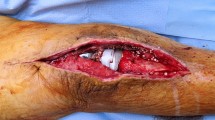Summary.
Total knee arthroplasty has become a routine procedure in surgery. Deep infections have an incidence of 2–5 %. Major risk factors are large prostheses, rheumatoid arthritis, diabetes mellitus and postoperative wound-healing complications. In large soft-tissue defects with skin necrosis, local wound care shows poor results, especially if loosening of the prosthesis and necrosis of the patellar ligament are evident. In these cases, no standard surgical therapy has been developed yet. Thus, we consider meticulous débridement with synovialectomy to be mandatory. Exchange of the prosthesis may be necessary. Soft-tissue coverage ought to be performed with a gastrocnemius muscle flap covered with a split-thickness skin graft. In the last three years, 11 patients with large soft-tissue defects and necrosis of the ligament were treated according to this concept. In all cases the muscle flap healed primarily and soft tissue coverage was excellent. Two patients who underwent single-stage removal and reimplantation of the prosthesis showed reinfections of the prosthesis. Reconstruction of the ligament was performed with the flap tendon. The patients with two-stage removal and reimplantation of the prosthesis and those who retained their implants had a good functional outcome. The gastrocnemius muscle flap provides easy and reliable soft-tissue reconstruction in large defects. In our patients a two-stage operation for reimplantation of the prosthesis was superior to a single-stage procedure. The reconstructed ligament should be reinforced with autologous material to prevent a secondary rupture. Early reconstruction with sufficient soft-tissue coverage and reconstruction of the ligament offers the patient the best chances of obtaining a good functional result and prevents arthrodesis or amputation. In addition, reconstructive surgery reduces the length of hospital stay and costs.
Zusammenfassung.
Die Implantation von Knieendoprothesen gehört heute zu den Routineeingriffen chirurgischer und orthopädischer Kliniken. Die Incidenz ausgedehnter Wundheilungsstörungen liegt bei 2–5 %. Als prädisponierend gelten große Prothesen, rheumatoide Arthritis und Diabetes mellitus. Kommt es im Rahmen der Infektion zu einem ausgedehnten Weichteildefekt mit Nekrose des Lig. patellae, freiliegender Prothese und zur septischen Lockerung der Prothese, ist die konservative Therapie mit antibiotischer Behandlung und Drainage allein insuffizient. In diesen Fällen ist aus unserer Sicht ein sorgfältiges Débridement mit Synovialektomie essentiell. Bei septischer Lockerung kann ein Prothesenwechsel notwendig werden. Die Defektdeckung erfolgt mit einem gestielten Gastrocnemiusmuskellappen mit Spalthauttransplantation, die Rekonstruktion des Lig. patellae mit dem Sehnenspiegel des M. gastrocnemius. In den letzten drei Jahren wurden 11 Patienten mit ausgedehnten Weichteildefekten und Beteiligung funktioneller Strukturen nach unserem Konzept behandelt. Bei allen Patienten konnten die Weichteile dauerhaft saniert werden, 2 wiesen nach einzeitigem Prothesenwechsel einen Reinfekt der Prothese auf. Neun Patienten hatten eine suffiziente Streckung im Kniegelenk mit ausreichendem Bewegungsumfang. Der Gastrocnemiuslappen bietet eine einfache und sichere Methode, Defekte nach Protheseninfektion zu decken. In unserem Patientengut zeigte sich, daß der zweizeitige Prothesenwechsel dem einzeitigen vorzuziehen ist. Durch eine frühe, interdisziplinäre Therapie mit Weichteilsanierung und Bandrekonstruktion bleibt den Patienten eine funktionsbehindernde Arthrodese oder Amputation erspart, gleichzeitig sinken die Dauer des Krankenhausaufenthalts und die Kosten für die Therapie um ein Vielfaches.
Similar content being viewed by others
Author information
Authors and Affiliations
Rights and permissions
About this article
Cite this article
Fansa, H., Plogmeier, K., Schenk, K. et al. Die Deckung ausgedehnter Weichteildefekte bei infizierten Knieendoprothesen durch Gastrocnemiuslappen. Chirurg 69, 1238–1243 (1998). https://doi.org/10.1007/s001040050562
Issue Date:
DOI: https://doi.org/10.1007/s001040050562




